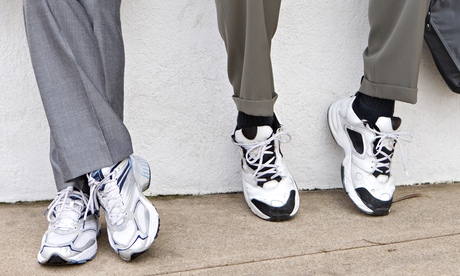
"Running has become socio-cosmic," anthropologist Allen Abramson announces to his attentive audience, a group of artists, academics, writers and, collectively, runners, gathered at the Slade School of Fine Art in London. What he means by this, I think, is that running is now everywhere. Even – as the first International Festival of Running (Run Run Run, or #r3fest) hosted by University College London last week attests – in the hallowed halls of the academic department, where such highfalutin claims are not, as they might be on the track, out of place.
But outside sports science, what interest does running have for the academic? And is running safe in our hands (or should that be shoes)?
About 50 of us have come for this inaugural conference, which is also the beginnings of a new Running Research Network, exploring the intersections of the scientific with the spiritual, cultural and political sides of the thing we all love to do – and now also to study. What is clear, however, from the footwear as much as the debate, is that we're runners first and foremost.
"We were worried it was just going to be the two of us," says Alan Latham, a senior lecturer in the department of geography at UCL, of himself and his co-organiser, the artist Kai Syng Tan. "But the response has been phenomenal."
They needn't have worried. As the popularity of running has exploded in parks and on the pavements, an interest in exploring it has grown in academic departments. One of the joys of this interest, keenly felt in the positive atmosphere of the festival, is that it draws people from all walks: the philosophers, the anthropologists, the performance artists, graphic designers, cultural geographers, English departments, music and meditation experts.
Perhaps only at a running conference would you get the choice over lunch of a running film festival; an injury clinic with Dr Courtney Kipps, the medical director of the London Triathlon; or guided breathing with Devashishu Torpy, the UK Peace Run coordinator. I opted for the meditation, attracted by the relation of long-distance running to self-transendence that has grown out of the Sri Chinmoy school of Buddhism, which combines spirituality with marathons.
What, no option of running? That was later, at 2.50pm, with Collectif Totem, a group of geographers and town planners from France and Italy who are mapping cities through running.
The conference's wide appeal is perhaps due to what "runner geographer" Hayden Lorimer describes as the "mythical and mundane" nature of running. Mythical in its origins and stories, from the Greek goddess Nike to today's feats of ultra-endurance. Mundane in the earthy and physical nature of planting your feet on to the earth, and the practicalities that requires.
As if to prove his metaphor, we're treated to a 45-minute exploration in excruciating detail of Lorimer's feet. While he gives the opening keynote, a webcam is focused on his calloused toes, the missing toenail he lost on the incline up Sentinel Dome in Yosemite national nark, the torn skin across the balls of his feet after coming down a mountain in Tenerife. It is the perfect opening and the ideal riposte to claims that academia does not have its feet on the ground. Here they are in all their grimy, battered glory.
"I've not lost a toenail yet," says Latham as he shows me around his Museum of Running, a collection of some of the first magazines, shoes and memorabilia from the beginnings of the running phenomenon in the 1960s and 70s, including the first ever published weekly training plan from Eugene, Oregon – home of Mo Farah's Nike Project team. "Perhaps I'm not a real runner until I do."
Some of the work being produced by artists and academics with and through their running throws a new light on the wider cultural, perhaps even political, implications of running. Véronique Chance's wonderful Great Orbital Run, a nine-day, 150-mile run around London, is not only an endurance event mapped on to a 10x10ft wall hanging, but also a commentary on the status of negotiating a global city, with its uncharted waste grounds, traffic problems, pollution and hidden beauty. It is every bit as provocative and insightful as Iain Sinclair's London Orbital.
With Ivo Gormley's GoodGym project on show, what was really being explored is what another academic, Dr Russell Hitchings, called the phenomenon of "green exercise", and the implications of how much better for you running in open green spaces can be over time in the gym.
"The idea of the conference was to bring people together and really see what all the difference disciplines could learn from one another," says Tan – a little like the "motion-controlled collisions" of a thousand footfalls hitting the ground. "There will definitely be a second conference," she continues. Around her neck are the whistle and stopwatch with which she timed, and then abruptly stopped, the conference papers after a firm eight minutes. Perhaps other conferences could take a leaf out of #r3fest's book.
• Alex Lockwood is a writer living in Newcastle, who teaches journalism at the University of Sunderland and runs for the Tyne Bridge Harriers.

